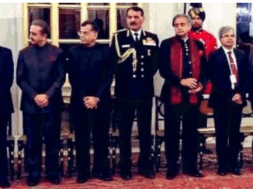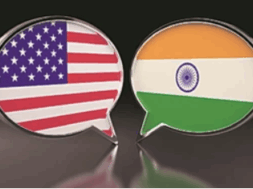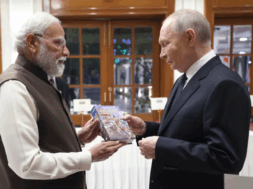
Roving Periscope: After India and 4 others, Russia also rejects China’s cartographic claims
Virendra Pandit
New Delhi: Trust China to publish new official maps each year claiming other’s territories, take two steps forward and one backward—meaning one step forward at a time—keep the claims frozen and use them in the future for raising more claims.
This is what the Dragon has been doing for centuries and expanded its domain beyond its natural boundaries. And this is what it did last Monday as well.
Everybody knows these Chinese cartographic and diplomatic tactics. Even with its alleged modernization and economic progress, when the rest of the world is dimming natural and national boundaries in a wave of globalization, a revanchist Beijing is always in an expansionist mode.
So, after India, Malaysia, Indonesia, the Philippines, and of course Taiwan, Russia has also rejected China’s latest claims over its territory in a new map Beijing published on Monday last week.
When asked about this controversy at a regular press briefing on Wednesday in Beijing, Foreign Ministry spokesman Wang Wenbin said, rather innocently, that he hoped the “relevant sides can remain objective and calm and refrain from overinterpreting.”
In a laughable remark, he said China released the map so publishers, companies, and others have an official version to reference. Foreign firms sometimes run into trouble with the Chinese government over how they use maps, he claimed.
Interestingly, Russia closed the deal with China on disputed territory in 2005. In fact, some 20 days before it invaded Ukraine in February 2022, Moscow had inked a “limitless friendship” pact with Beijing to keep the second-largest economy in good humor.
President Vladimir Putin thought his Chinese counterpart Xi Jinping was the only leader he could really depend upon and cry on his shoulders.
However, finding Russia vulnerable now China reopened the file. After six countries registered strong protests over the new map, Moscow also woke up.
While India, Taiwan, and the Philippines are being subjected to Chinese expansionist designs, Russia, the ‘closest’ partner of China, was surprised at this back-stabbing. Given Russia’s increasing dependence on China, however, its response was rather mute. Mildly rejecting the Chinese claims, it only said the map was against the bilateral agreement signed in 2005.
China has claimed that Bolshoi Ussuriysky Island was, in its entirety, Chinese territory. After decades of conflict, and even a war in 1969, they had seemingly resolved the issue in 2005, and the partition of the island, disputed since the 1860s, was completed by 2008.
Under the deal, China got 170 of the 350 sq km of the island and Russia kept the rest of it. Additionally, the smaller islands of Vinogradov, Koreysky, and Romashkin were also handed over to China to resolve the dispute.
On Monday, Russian Foreign Ministry Spokesperson Maria Zakharova reiterated this deal as it rejected fresh Chinese claims.
In all, China has claims over territories of 16 countries: India, Nepal, Bhutan, Myanmar, Russia, The Philippines, Vietnam, Japan, Indonesia, Malaysia, Laos, South Korea, North Korea, Mongolia, Myanmar, and Singapore. The list excludes Taiwan, an independent self-ruling island that Beijing claims as a breakaway island it is committed to unifying with the mainland, even by using force.
China also claims Japan’s Senkaku Islands which it calls Diaoyu Islands.
Interestingly, China claims over 80 percent of the South China Sea on the basis of a 1947 map showing vague dashes – the nine-dash line — looping down to a point about 1,100 miles (1,800 km) south of Hainan Island.
Vietnam, the Philippines, Brunei, Malaysia, and Taiwan all claim parts of the same maritime area and have sparred with China over where their boundaries lay.
Look at China’s fresh claims. In India, it claimed Aksai Chin of Ladakh and the state of Arunachal Pradesh; much of the South China Sea from Southeast Asian countries like the Philippines, Malaysia, and Indonesia; and Bolshoi Ussuriysky Island from Russia.
Nepal’s objection was unique as it protested the inclusion of three Indian territories —Limpiyadhura, Kalapani, and Lipulekh— that it claims as its own within Indian borders by the Chinese map.
In the case of India, China claims Ladakh as part of Western Tibet and Arunachal as Southern Tibet.
Russia’s Bolshoi Ussuriysky island, which China has now claimed in its entirety, and the surrounding region are at the confluence of the Ussuri and Amur rivers that separate the two countries.
“The Russian and Chinese sides adhere to the common position that the border issue between our countries has been finally resolved. Its settlement was marked by the ratification in 2005 of the Supplementary Agreement on the Russian-Chinese state border on its eastern part, according to which Bolshoi Ussuriysky Island was divided between the parties. The delimitation and demarcation of our common border has been completed along its entire length (almost 4,300 km or 2,670 miles), including in 2008 on Bolshoi Ussuriysky Island.”
Zakharova said the “resolution” of the dispute “was the result of many years of efforts by both sides, a reflection of the high level of relations between the two countries, made an important contribution to ensuring security and stability in the region, and is a successful example of resolving border disputes for all countries of the world.”
“Russia and China have repeatedly confirmed the absence of mutual territorial claims, and there is a corresponding provision in the Treaty on Good Neighborliness, Friendship and Cooperation of July 16, 2001. The parties have an extensive structure of interaction in the field of border cooperation, and the Joint Border Commission is functioning effectively, within which all relevant issues are discussed,” said Zakharova.













